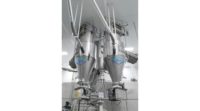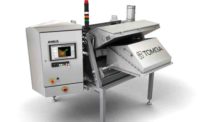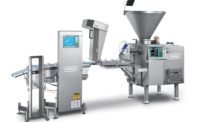Ingredient handling equipment to maximize efficiency and throughput
Automated ingredient handling and connectivity help reduce waste while increasing throughput.

courtesy of Key Technology

courtesy of VAC-U-MAX

courtesy of Powder Process-Solutions

courtesy of Piab

courtesy of Bühler Inc.











Automation has begun to take over the world of sorting and ingredient handling among snack and bakery products, especially in the area of continuous batching and delivery systems. Connectivity has enabled control systems to better communicate and further the perennial twin goals of reducing waste and increasing throughput.
Pneumatic ingredient handling has seen incremental rather than revolutionary changes, according to Doan Pendleton, vice president, VAC-U-MAX, Belleville, NJ. The overall principles of the equipment haven’t changed, although technology in areas like mechanical blowers continues to be upgraded, he says.
“Everybody thinks they have a better mousetrap—or a better air-compressed-driven unit,” says Pendleton. “One of the things we try to do is tweak our design so it better fits the customer’s needs in a broader sense, like redesigning a vacuum receiver so a larger group of powders would discharge from it.”
David Kennedy, manager of business development, VAC-U-MAX, says pneumatic conveying has experienced “fractional changes” over the years. “We’re still vacuuming material, and blowing material, and filtering and discharging it. A car is still a car, like when Henry Ford invented it, but it’s got a lot more niceties and capabilities.”
We’re all connected
Among the more-recent innovations has been a wider array of electronics and instrumentation, and greater connectivity as production facilities begin to wire equipment into the internet of things (IoT) so people can communicate remotely with their equipment and keep it humming, Kennedy says.
The WinCos systems developed by Bьhler Inc., Plymouth, MN, provide a range of functionality to deliver recipe management and control linked through communication, according to John Hunter, sales account manager, bakery and ingredient handling.
“There are big developments online where we can measure and use the data we get—if you can see variation, you can make adjustments in the process,” says Hunter. “The connectivity of the different systems and the use of the internet and other communications is critical. The ability to gather information in a timely manner, such as the temperature or something else, allows you to track and do something with it. I can now optimize my process.”
Key Technology, Walla Walla, WA, offers data that provides a better picture of what’s happening throughout a plant, rather than just one ingredient sorting and handling machine, thanks to communication through the IoT, says John Kadinger, market manager. “You click the data, and in real time you can make changes,” he says. A company can figure out if they are being consistent in production, identify where the attention needs to be, and where there are any issues. “We can use the information to reduce waste and increase throughput.”
Clean and safe
Powder Process-Solutions, Chanhassen, MN, has heard increased sentiment about the need for easier-to-clean equipment, says Clyde Waller, systems engineer—equipment that’s quick to take apart, easy to clean and easy to inspect, he says. The company’s BFM Flex Connector, a clampless sanitary connect, meets those needs. “It’s not new, but we’re seeing it sell more frequently.”
Allergen control is also a top issue today. VAC-U-MAX has seen customers buy specific systems focused on cleanability so that an ingredient that’s an allergen doesn’t get transmitted to the next department, Kennedy says. “The ability to clean the equipment, or have dedicated equipment if they are handling allergens, is really important.”
Piab offers piFLOW vacuum conveyors, like the piFLOW f, that feature a small footprint with flexible routing of pipelines. Their hygienic design makes them easy to clean and maintain, enabling quick changeover times and contributing to greater process uptime. Special features mitigate segregation issues. Accessories include suction pipes to provide a lightweight, ergonomic solution for free-flowing or granular materials and feed nozzles for more-challenging materials that allow the air intake to be adjusted for the optimum mixture of conveyed material and aspirated air.
Bьhler Inc. is frequently asked about allergen control and reducing the risk of cross-contamination, Hunter says. “Being able to control your ingredients is becoming more critical.”
Bьhler’s optical sorters detect defective product and eject it with forced air into the reject stream, says Tracey Ibbotson, public relations. These include the SORTEX E BioVision equipment for nut producers, which helps simultaneously sort for defects and foreign material contamination.
These concerns “could originate from the product itself, which the consumer is not expecting to eat—such as a shell or hull in ready-to-eat nuts—or objects such as sticks, stones, glass or plastic which come from the field, transport or manufacturing stages,” says Ibbotson. “Other growing areas of food safety concern facing our customers are non-declared allergens, such as gluten-containing foreign kernels in gluten-free products and the widespread presence of mold fungi and their hazardous metabolites.”
The need for speed
Pneumatic conveying systems need continuous filter upgrades to reduce downtime and increase throughput, Pendleton says. “We’re always on the lookout for better filtration in our systems. The better that operates, the longer you can go without extended downtime.” As powders get finer and finer, this has become even more of an issue.
The growth in the organic food industry has underscored the need for better throughput as small, organic-only businesses are absorbed into larger mainstream companies, Kennedy says. “Those guys need to automate where they used to hand-scoop products. Vacuum conveying in particular eliminates a lot of the manual handling.”
Better throughput is an ongoing concern, Waller says. “I can’t tell you how many times we’ve tweaked systems into doing more than they were originally designed for. Certainly there’s a limit, and we’re seeing a lot of activity related to companies reaching those limits.”
Waste not, want not
VAC-U-MAX has been stepping up its capabilities in waste reduction, Pendleton says. “One of the applications we’ve done here a lot is a topping application, where you might have a conveyor belt full of bagels, and you’re putting sesame seeds on top of them, you need to be capturing the seeds that don’t land on the bagels. Being able to recover that material and reuse it is key to reducing waste.”
Managing false rejects is also vital to minimizing waste. The VERYX digital sorter from Key Technology is more precise than previous equipment in identifying defects and more precisely rejecting unwanted material, Kadinger says. “It operates more efficiently without operator intervention,” he says. “From the control perspective, all the operator has to do is choose the recipe. We also have intelligence built into the system so we can integrate information from the control system and automate that process through information that’s available in the system.”
Automation has factored out operator error in dosing and mixing ingredients during recipe management, Hunter says. “Anything that automates dosing and recipe management reduces waste and errors,” he says. “That’s a big driver in terms of up-time.”
Best practices for ingredient transportation
Too often transportation providers refer to ingredients as commodities, focusing just on the movement, not the handling, of the product. Yet anyone who produces or buys ingredients knows that transport requires an extra level of attention and service.
Here are best practices to consider when working with a third-party transportation provider for the movement of proteins, sugars, spices or specialty products.:
Time-sensitive. With ingredients, on-time delivery is vital. When delivering critical raw materials into a food manufacturing facility, a late shipment can mean a production shutdown and a loss of thousands of dollars. Make sure to work with a provider who takes the extra time to speak directly with your facilities when scheduling a delivery appointment, communicating details and asking about preferences. Other signs of a service-focused transportation provider include order tracking technology, proactive communication standards, and a track record of meeting must-arrive-by dates.
Heavy totes. When shipping totes that weigh 2,500 lbs. or more, avoid wrapping pallets with plastic. Product can shift too easily and cause offloading issues or damage. To prevent against shifting, place air bags between pallets and/or leverage nylon straps to strengthen the connection between product and platform.
Contamination. For ingredients, there’s no room for equipment tainted with bad smells or moisture. Dry and powdered products tend to take on the flavors and smells of the things around them, so trailers must be void of any possible contaminates. Working with a logistics partner that has a network of food-grade equipment and strict carrier qualification standards is the best way to prevent against issues with ingredient safety and quality control. Additionally, don’t hesitate to ask about their FSMA compliance standards.
—Jesse Juett, Senior Business Development Representative, Zipline Logistics
Looking for a reprint of this article?
From high-res PDFs to custom plaques, order your copy today!














